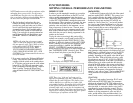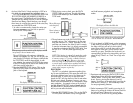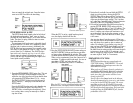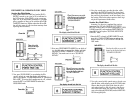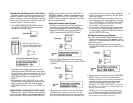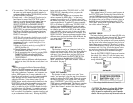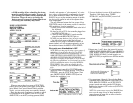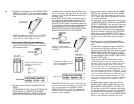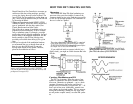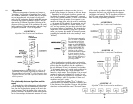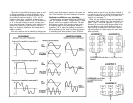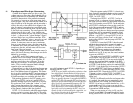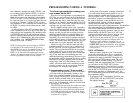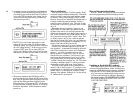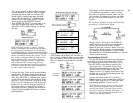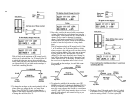
HOW THE DX7 CREATES SOUNDS
Breath Controller or Foot Controller) to turn notes up
and down within the existing envelopes, provided
you are also playing the notes on the keyboard. The
more EG bias, the less amplitude is present when you
play a note; the level increases when you add EG bias
by advancing the Wheel.
7. When you've experimented with [MODULATION
WHEEL-EG BIAS], turn it OFF, and try each of the 3
types of modulation with the other sources (Foot
Control, Breath control and After Touch).
Each of the above sources of modulation can be pro-
grammed to function differently, so this is not neces-
sarily a redundant system. For example, you might
use the after touch to add pitch modulation, the mod-
ulation wheel to add amplitude modulation, and the
breath controller to alter EG bias (blowing notes,
provided you first hold down the key(s)) for a given
voice.
8. After you've explored all the modulation functions,
we recommend that you go through them and set
them in a way that will be useful as you work
through other sections of this manual. Therefore,
please set the modulation as follows:
CONTROLLER
MODULATION WHEEL
FOOT CONTROL
BREATH CONTROL
AFTER TOUCH
FUNCTION
RANGE
50
51)
50
50
PITCH
ON
ON
ON
ON
AMPLITUDE
OFF
OFF
OFF
OFF
EG BIAS
OFF
OFF
OFF
OFF
(These settings are not ideal for all voices. If, for in-
stance. you're playing the voice called "SAX - BC1", you
will want to turn ON the Breath Controller EG bias, and
perhaps set Us range to 99.)
Operators
The Yamaha DX Series FM digital synthesizers use
pure tones (sine waves) that interact to create all the
overtones needed for any voice. Each sine wave oscilla-
tor has its own envelope generator. The combination of
the two is called an "operator."
The primary functional circuit in the DX7 is comprised
of the digital SINE WAVE OSCILLATOR plus a digital
ENVELOPE GENERATOR with multiple inputs and just
one output. This is called an OPERATOR.
If you could look inside an operator (which is just a
digital circuit), you might see a block structure that looks
like this:
Carriers, Modulators and
FM
The DX7 has 6 operators. When the output of one
operator is connected to the input of another, modula-
tion occurs. Harmonics are generated — up to a whole
spectrum of frequencies that are the equivalent of a
triangle wave or a sawtooth or a square wave, etc. — all
from a pair of sine waves. Additionally, operator's sine
wave outputs can be mixed together. The two processes,
mixing and modulating (whereby the sine waves inter-
act and produce complex sounds), are called FM synthe-
sis.
When the output of one OPERATOR is "patched" to the
input of another Operator, the result is a complex wave-
form. This is the essence of FM SYNTHESIS.



